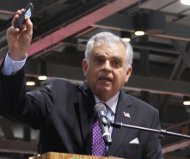Article from: www.thenewspaper.com/news/37/3768.asp
4/17/2012
Feds Continue Push to Stop Drivers With Cell Phones
Effort to ticket cell phone use while driving has had no effect on accident rates.
 US Transportation Secretary Ray LaHood declared April to be "National Distracted Driving Awareness Month." The former Illinois congressman is using the occasion to pressure states to adopt laws that allow police to issue traffic tickets to drivers who use a cell phone or send a text message behind the wheel. LaHood especially praised West Virginia earlier this month for becoming the thirty-sixth state to ban mobile phone use.
US Transportation Secretary Ray LaHood declared April to be "National Distracted Driving Awareness Month." The former Illinois congressman is using the occasion to pressure states to adopt laws that allow police to issue traffic tickets to drivers who use a cell phone or send a text message behind the wheel. LaHood especially praised West Virginia earlier this month for becoming the thirty-sixth state to ban mobile phone use.
"Our warmest congratulations today, from everyone at DOT, go to West Virginia," LaHood said on April 3. "In visits to three different high schools, Governor Earl Ray Tomblin will sign the state's new texting and hand-held cell phone ban. The new law makes texting behind the wheel a primary traffic offense starting in July. Talking on a hand held cell phone will be a secondary offense beginning in July of this year, but in July 2013, that becomes a primary offense as well."
The switch to primary enforcement is essential, because it allows police to issue tickets to motorists who are texting while stopped at a traffic light or stuck in heavy freeway traffic. In California, the state Court of Appeal made it clear last November that a $211 fine applied to anyone using a cell phone while in the driver's seat of a fully stopped automobile (view opinion). Between 2008 and 2010, the California Highway Patrol had issued 283,000 cell phone citations, but the percentage of accidents caused by mobile use has remained steady at about 0.1 percent of collisions.
"There has not been an appreciable decrease in the number of persons involved in either fatal or injury collisions where cell phone use was a factor as a percentage of the total number of persons involved in a collisions after the cell phone laws went into effect," the California Senate Transportation and Housing Committee reported.
The National Highway Traffic Safety Administration (NHTSA) claims that distracted driving caused 5084 fatal crashes in 2009, of which 867 accident reports specifically cited cell phone use as a cause. According to the wireless association CTIA, there were 291 million cell phone subscriptions in 2009, a number that grew seven percent to 311 million the following year and to 331 million today -- greater than the total US population.
Despite this rapid expansion in cell phone use, the number of fatal traffic collisions involving passenger vehicles dropped 5.4 percent from 2009 to 2010. The total number of road deaths was lower than they have been since 1949 and the fatality rate is at an all time low of 1.10 deaths per 100 million vehicle miles traveled.
Of the states with no laws banning cell phone use or text messaging behind the wheel, accidents in Arizona dropped 5.5 percent, Florida dropped 4.5 percent, Missouri dropped 6.7 percent, Montana dropped 14 percent, South Carolina dropped 9.4 percent. Only two states without such laws saw higher accident rates: Ohio increased 5.7 percent, South Dakota increased 6.9 percent.
 US Transportation Secretary Ray LaHood declared April to be "National Distracted Driving Awareness Month." The former Illinois congressman is using the occasion to pressure states to adopt laws that allow police to issue traffic tickets to drivers who use a cell phone or send a text message behind the wheel. LaHood especially praised West Virginia earlier this month for becoming the thirty-sixth state to ban mobile phone use.
US Transportation Secretary Ray LaHood declared April to be "National Distracted Driving Awareness Month." The former Illinois congressman is using the occasion to pressure states to adopt laws that allow police to issue traffic tickets to drivers who use a cell phone or send a text message behind the wheel. LaHood especially praised West Virginia earlier this month for becoming the thirty-sixth state to ban mobile phone use.